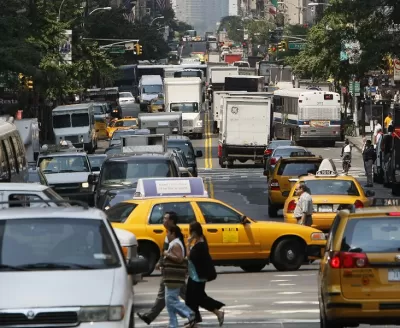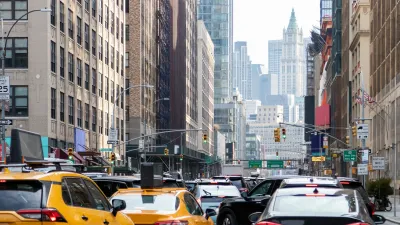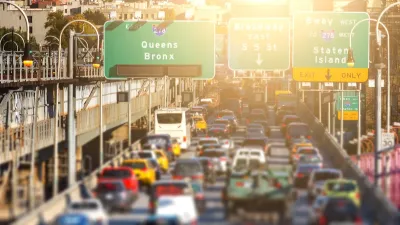The program would be the first cordon pricing scheme in the United States.

The U.S. Department of Transportation approved environmental reviews for New York City’s congestion pricing plan, clearing one of the city’s biggest obstacles to implementing the program.
As Daniel C. Vock explains in Route Fifty, the program, also known as cordon pricing, could raise up to $1 billion per year, much of which would go toward funding the city’s transit system. “The cordoned-off area would include all of Manhattan south of 60th Street. Tolls are expected to be between $9 and $23 per vehicle, but local officials have not yet decided the rate.”
Supporters of congestion pricing say the plan would boost public transit funding, improving service for transit commuters, and reduce congestion on roads, improving commutes for drivers.
While no other U.S. city uses congestion pricing yet, the practice has shown positive results in London, Stockholm, and other international cities. “Tiffany-Ann Taylor, vice president for transportation at the Regional Plan Association (RPA), said the effects on downtown streets should be quick to see once the tolling plan is put into place, even if it takes a few years for physical improvements to the subway system to take shape.”
Some local politicians are wary of the plan, saying it penalizes New Jersey workers who commute into the city. Taylor counters the claim, saying that “The fact of the matter is the folks who are commuting to New Jersey are mostly coming in through public transit … Folks who live in New Jersey and other parts of the region actually are benefiting directly from the program.”
FULL STORY: Congestion Pricing in Manhattan Clears Federal Hurdle

Study: Maui’s Plan to Convert Vacation Rentals to Long-Term Housing Could Cause Nearly $1 Billion Economic Loss
The plan would reduce visitor accommodation by 25,% resulting in 1,900 jobs lost.

North Texas Transit Leaders Tout Benefits of TOD for Growing Region
At a summit focused on transit-oriented development, policymakers discussed how North Texas’ expanded light rail system can serve as a tool for economic growth.

Why Should We Subsidize Public Transportation?
Many public transit agencies face financial stress due to rising costs, declining fare revenue, and declining subsidies. Transit advocates must provide a strong business case for increasing public transit funding.

How to Make US Trains Faster
Changes to boarding platforms and a switch to electric trains could improve U.S. passenger rail service without the added cost of high-speed rail.

Columbia’s Revitalized ‘Loop’ Is a Hub for Local Entrepreneurs
A focus on small businesses is helping a commercial corridor in Columbia, Missouri thrive.

Invasive Insect Threatens Minnesota’s Ash Forests
The Emerald Ash Borer is a rapidly spreading invasive pest threatening Minnesota’s ash trees, and homeowners are encouraged to plant diverse replacement species, avoid moving ash firewood, and monitor for signs of infestation.
Urban Design for Planners 1: Software Tools
This six-course series explores essential urban design concepts using open source software and equips planners with the tools they need to participate fully in the urban design process.
Planning for Universal Design
Learn the tools for implementing Universal Design in planning regulations.
Ascent Environmental
Borough of Carlisle
Institute for Housing and Urban Development Studies (IHS)
City of Grandview
Harvard GSD Executive Education
Toledo-Lucas County Plan Commissions
Salt Lake City
NYU Wagner Graduate School of Public Service





























